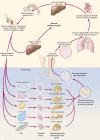Advances in the Diagnosis of Human Schistosomiasis
- PMID: 26224883
- PMCID: PMC4548261
- DOI: 10.1128/CMR.00137-14
Advances in the Diagnosis of Human Schistosomiasis
Abstract
Schistosomiasis is a major neglected tropical disease that afflicts more than 240 million people, including many children and young adults, in the tropics and subtropics. The disease is characterized by chronic infections with significant residual morbidity and is of considerable public health importance, with substantial socioeconomic impacts on impoverished communities. Morbidity reduction and eventual elimination through integrated intervention measures are the focuses of current schistosomiasis control programs. Precise diagnosis of schistosome infections, in both mammalian and snail intermediate hosts, will play a pivotal role in achieving these goals. Nevertheless, despite extensive efforts over several decades, the search for sensitive and specific diagnostics for schistosomiasis is ongoing. Here we review the area, paying attention to earlier approaches but emphasizing recent developments in the search for new diagnostics for schistosomiasis with practical applications in the research laboratory, the clinic, and the field. Careful and rigorous validation of these assays and their cost-effectiveness will be needed, however, prior to their adoption in support of policy decisions for national public health programs aimed at the control and elimination of schistosomiasis.
Copyright © 2015, American Society for Microbiology. All Rights Reserved.
Figures
References
-
- WHO. 2014. Schistosomiasis fact sheet 115. World Health Organization, Geneva, Switzerland: http://www.who.int/mediacentre/factsheets/fs115/en/.
Publication types
MeSH terms
LinkOut - more resources
Full Text Sources
Research Materials







